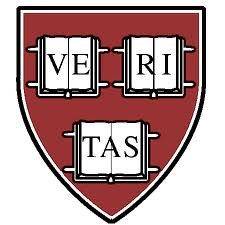From The Harvard-Smithsonian Center for Astrophysics (US)
12.03.21
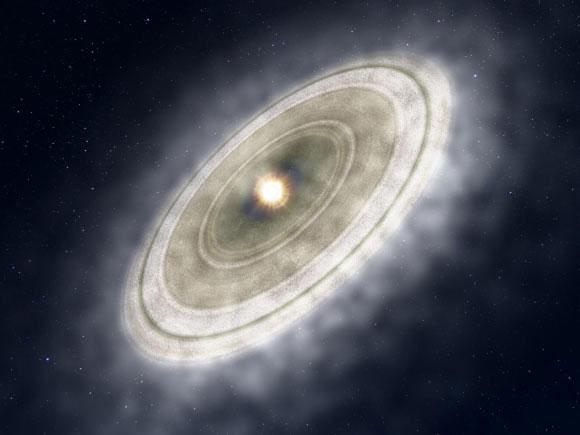
An artist’s impression of a star’s dusty debris disk, thought to be produced when asteroids or other planetesimals collide and fragment. Astronomers studying the debris disk around the star HD 206893 have imaged a wide gap in the disk extending from about 50 to 185 au from the star. After modeling the system, they conclude it contains a 1.4 Jupiter-mass planet orbiting about 79 au from the central star.
The National Astronomical Observatory of Japan[[国立天文台](JP)
Debris disks around main-sequence stars are tenuous belts of dust thought to be produced when asteroids or other planetesimals collide and fragment. They are common: more than about a quarter of all main-sequence stars have debris disks and, since these disks can be hard to detect, it is likely that the fraction is even higher. Current instruments are only able to detect debris disks in systems that are at least an order of magnitude more luminous than the disk generated by the solar system’s Kuiper Belt (the region extending from the orbit of Neptune at about thirty astronomical units out to about fifty au).
The dust in debris disks is worthy of study in its own right but also offers an opportunity to trace the properties of planetary systems. The largest dust grains (those as big as a millimeter), whose collective thermal emission is measured with telescopes like ALMA (Atacama Large Millimeter/submillimeter Array), are relatively unaffected by stellar winds or radiation pressure.
 European Southern Observatory/National Radio Astronomy Observatory(US)/National Astronomical Observatory of Japan(JP) ALMA Observatory (CL)
European Southern Observatory/National Radio Astronomy Observatory(US)/National Astronomical Observatory of Japan(JP) ALMA Observatory (CL)
Rather, their distribution reveals the effects of gravity and collisions. The “chaotic zone” is the extended region around a planet within which dust has no stable gravitational orbits, resulting in a gap whose width depends among other things on the planet’s mass. A planet in a debris disk can create such a gap, and measurements of the gap’s dimensions can thus be used to deduce the mass of the planet – a key exoplanet parameter that is otherwise difficult to obtain.
CfA astronomers Sean Andrews and David Wilner were members of a team that used ALMA to study the known debris disk around the star HD 206893 about 135 light-years away from us. The star also has a brown dwarf binary companion orbiting at about 10au and whose mass is about 15-30 Jupiter-masses. The ALMA images spatially resolve the disk – it extends from about 50 -185 au – and the astronomers find evidence for a gap stretching from about 63 – 94 au. If the gap was carved by a single planet in a circular orbit, chaotic zone theory implies the planet should have a mass of about 1.4 Jupiter-masses and orbit at about 79 au. Future, higher resolution ALMA observations have the potential to help constrain the dynamical behavior of the brown dwarf as well as to improve the characterization of the inferred new planet.
Science paper:
The Astrophysical Journal
See the full article here .

five-ways-keep-your-child-safe-school-shootings
Please help promote STEM in your local schools.
The The Harvard-Smithsonian Center for Astrophysics (US) combines the resources and research facilities of the Harvard College Observatory(US) and the Smithsonian Astrophysical Observatory(US) under a single director to pursue studies of those basic physical processes that determine the nature and evolution of the universe. The Smithsonian Astrophysical Observatory(US) is a bureau of the Smithsonian Institution(US), founded in 1890. The Harvard College Observatory, founded in 1839, is a research institution of the Faculty of Arts and Sciences, Harvard University(US), and provides facilities and substantial other support for teaching activities of the Department of Astronomy.
Founded in 1973 and headquartered in Cambridge, Massachusetts, the CfA leads a broad program of research in astronomy, astrophysics, Earth and space sciences, as well as science education. The CfA either leads or participates in the development and operations of more than fifteen ground- and space-based astronomical research observatories across the electromagnetic spectrum, including the forthcoming Giant Magellan Telescope(CL) and the Chandra X-ray Observatory(US), one of NASA’s Great Observatories.
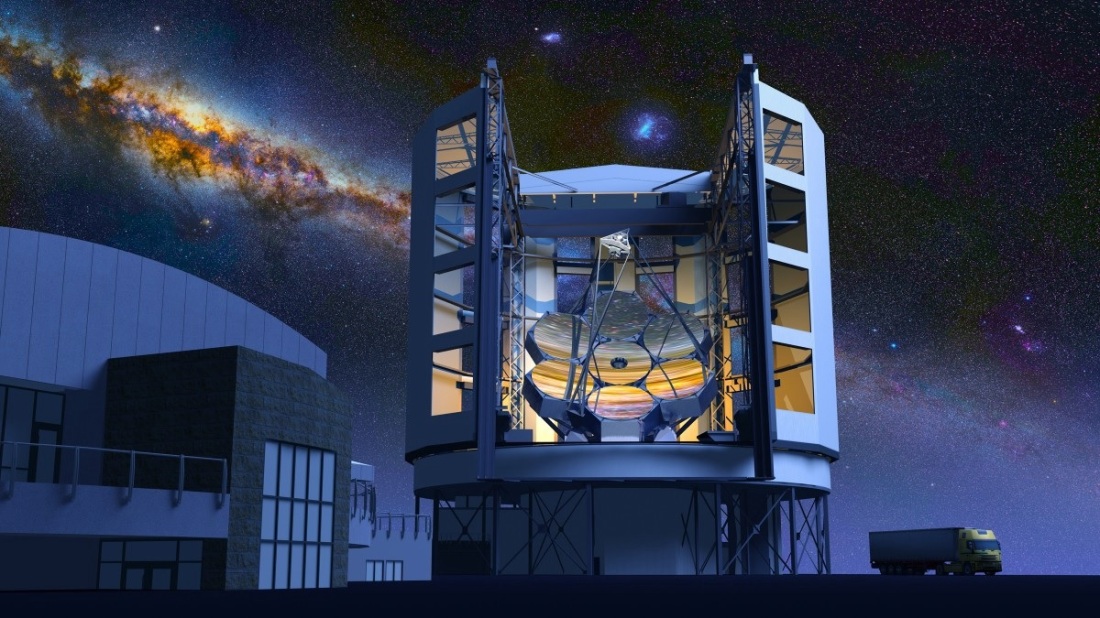 Giant Magellan Telescope(CL) 21 meters, to be at the Carnegie Institution for Science’s(US) NSF (US) NOIRLab(US) NOAO(US) Las Campanas Observatory(CL) some 115 km (71 mi) north-northeast of La Serena, Chile, over 2,500 m (8,200 ft) high.
Giant Magellan Telescope(CL) 21 meters, to be at the Carnegie Institution for Science’s(US) NSF (US) NOIRLab(US) NOAO(US) Las Campanas Observatory(CL) some 115 km (71 mi) north-northeast of La Serena, Chile, over 2,500 m (8,200 ft) high.
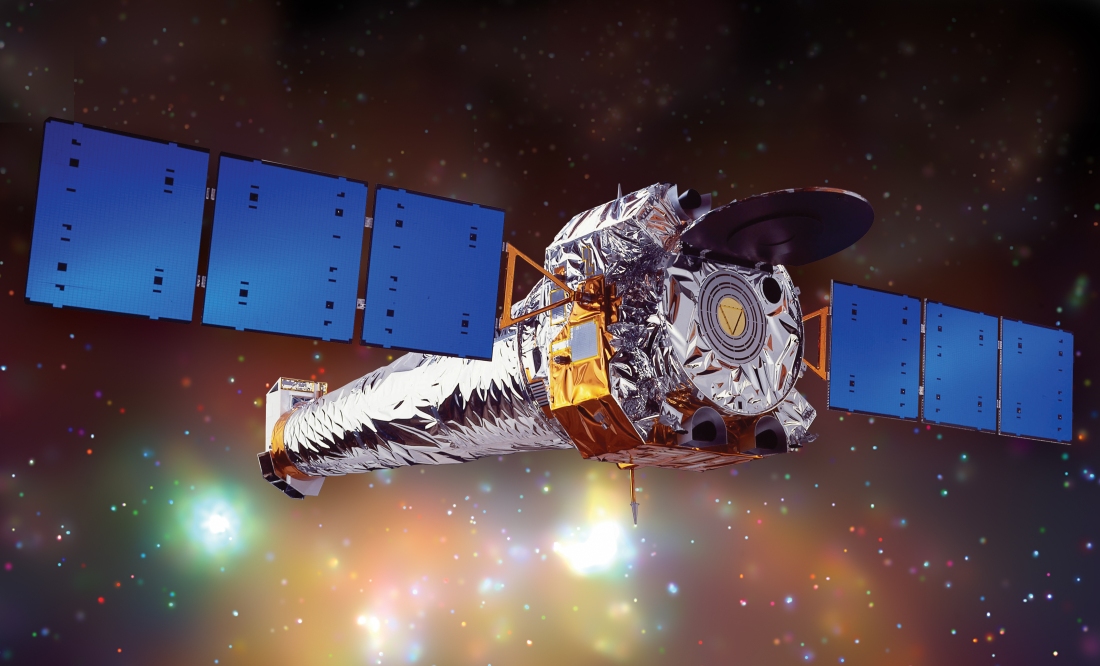 National Aeronautics and Space Administration(US) Chandra X-ray telescope(US).
National Aeronautics and Space Administration(US) Chandra X-ray telescope(US).
Hosting more than 850 scientists, engineers, and support staff, the CfA is among the largest astronomical research institutes in the world. Its projects have included Nobel Prize-winning advances in cosmology and high energy astrophysics, the discovery of many exoplanets, and the first image of a black hole. The CfA also serves a major role in the global astrophysics research community: the CfA’s Astrophysics Data System(ADS)(US), for example, has been universally adopted as the world’s online database of astronomy and physics papers. Known for most of its history as the “Harvard-Smithsonian Center for Astrophysics”, the CfA rebranded in 2018 to its current name in an effort to reflect its unique status as a joint collaboration between Harvard University and the Smithsonian Institution. The CfA’s current Director (since 2004) is Charles R. Alcock, who succeeds Irwin I. Shapiro (Director from 1982 to 2004) and George B. Field (Director from 1973 to 1982).
The Center for Astrophysics | Harvard & Smithsonian is not formally an independent legal organization, but rather an institutional entity operated under a Memorandum of Understanding between Harvard University and the Smithsonian Institution. This collaboration was formalized on July 1, 1973, with the goal of coordinating the related research activities of the Harvard College Observatory (HCO) and the Smithsonian Astrophysical Observatory (SAO) under the leadership of a single Director, and housed within the same complex of buildings on the Harvard campus in Cambridge, Massachusetts. The CfA’s history is therefore also that of the two fully independent organizations that comprise it. With a combined lifetime of more than 300 years, HCO and SAO have been host to major milestones in astronomical history that predate the CfA’s founding.
History of the Smithsonian Astrophysical Observatory (SAO)
Samuel Pierpont Langley, the third Secretary of the Smithsonian, founded the Smithsonian Astrophysical Observatory on the south yard of the Smithsonian Castle (on the U.S. National Mall) on March 1,1890. The Astrophysical Observatory’s initial, primary purpose was to “record the amount and character of the Sun’s heat”. Charles Greeley Abbot was named SAO’s first director, and the observatory operated solar telescopes to take daily measurements of the Sun’s intensity in different regions of the optical electromagnetic spectrum. In doing so, the observatory enabled Abbot to make critical refinements to the Solar constant, as well as to serendipitously discover Solar variability. It is likely that SAO’s early history as a solar observatory was part of the inspiration behind the Smithsonian’s “sunburst” logo, designed in 1965 by Crimilda Pontes.
In 1955, the scientific headquarters of SAO moved from Washington, D.C. to Cambridge, Massachusetts to affiliate with the Harvard College Observatory (HCO). Fred Lawrence Whipple, then the chairman of the Harvard Astronomy Department, was named the new director of SAO. The collaborative relationship between SAO and HCO therefore predates the official creation of the CfA by 18 years. SAO’s move to Harvard’s campus also resulted in a rapid expansion of its research program. Following the launch of Sputnik (the world’s first human-made satellite) in 1957, SAO accepted a national challenge to create a worldwide satellite-tracking network, collaborating with the United States Air Force on Project Space Track.
With the creation of National Aeronautics and Space Administration(US) the following year and throughout the space race, SAO led major efforts in the development of orbiting observatories and large ground-based telescopes, laboratory and theoretical astrophysics, as well as the application of computers to astrophysical problems.
History of Harvard College Observatory (HCO)
Partly in response to renewed public interest in astronomy following the 1835 return of Halley’s Comet, the Harvard College Observatory was founded in 1839, when the Harvard Corporation appointed William Cranch Bond as an “Astronomical Observer to the University”. For its first four years of operation, the observatory was situated at the Dana-Palmer House (where Bond also resided) near Harvard Yard, and consisted of little more than three small telescopes and an astronomical clock. In his 1840 book recounting the history of the college, then Harvard President Josiah Quincy III noted that “…there is wanted a reflecting telescope equatorially mounted…”. This telescope, the 15-inch “Great Refractor”, opened seven years later (in 1847) at the top of Observatory Hill in Cambridge (where it still exists today, housed in the oldest of the CfA’s complex of buildings). The telescope was the largest in the United States from 1847 until 1867. William Bond and pioneer photographer John Adams Whipple used the Great Refractor to produce the first clear Daguerrotypes of the Moon (winning them an award at the 1851 Great Exhibition in London). Bond and his son, George Phillips Bond (the second Director of HCO), used it to discover Saturn’s 8th moon, Hyperion (which was also independently discovered by William Lassell).
Under the directorship of Edward Charles Pickering from 1877 to 1919, the observatory became the world’s major producer of stellar spectra and magnitudes, established an observing station in Peru, and applied mass-production methods to the analysis of data. It was during this time that HCO became host to a series of major discoveries in astronomical history, powered by the Observatory’s so-called “Computers” (women hired by Pickering as skilled workers to process astronomical data). These “Computers” included Williamina Fleming; Annie Jump Cannon; Henrietta Swan Leavitt; Florence Cushman; and Antonia Maury, all widely recognized today as major figures in scientific history. Henrietta Swan Leavitt, for example, discovered the so-called period-luminosity relation for Classical Cepheid variable stars, establishing the first major “standard candle” with which to measure the distance to galaxies. Now called “Leavitt’s Law”, the discovery is regarded as one of the most foundational and important in the history of astronomy; astronomers like Edwin Hubble, for example, would later use Leavitt’s Law to establish that the Universe is expanding, the primary piece of evidence for the Big Bang model.
Upon Pickering’s retirement in 1921, the Directorship of HCO fell to Harlow Shapley (a major participant in the so-called “Great Debate” of 1920). This era of the observatory was made famous by the work of Cecelia Payne-Gaposchkin, who became the first woman to earn a Ph.D. in astronomy from Radcliffe College (a short walk from the Observatory). Payne-Gapochkin’s 1925 thesis proposed that stars were composed primarily of hydrogen and helium, an idea thought ridiculous at the time. Between Shapley’s tenure and the formation of the CfA, the observatory was directed by Donald H. Menzel and then Leo Goldberg, both of whom maintained widely recognized programs in solar and stellar astrophysics. Menzel played a major role in encouraging the Smithsonian Astrophysical Observatory to move to Cambridge and collaborate more closely with HCO.
Joint history as the Center for Astrophysics (CfA)
The collaborative foundation for what would ultimately give rise to the Center for Astrophysics began with SAO’s move to Cambridge in 1955. Fred Whipple, who was already chair of the Harvard Astronomy Department (housed within HCO since 1931), was named SAO’s new director at the start of this new era; an early test of the model for a unified Directorship across HCO and SAO. The following 18 years would see the two independent entities merge ever closer together, operating effectively (but informally) as one large research center.
This joint relationship was formalized as the new Harvard–Smithsonian Center for Astrophysics on July 1, 1973. George B. Field, then affiliated with UC Berkeley(US), was appointed as its first Director. That same year, a new astronomical journal, the CfA Preprint Series was created, and a CfA/SAO instrument flying aboard Skylab discovered coronal holes on the Sun. The founding of the CfA also coincided with the birth of X-ray astronomy as a new, major field that was largely dominated by CfA scientists in its early years. Riccardo Giacconi, regarded as the “father of X-ray astronomy”, founded the High Energy Astrophysics Division within the new CfA by moving most of his research group (then at American Sciences and Engineering) to SAO in 1973. That group would later go on to launch the Einstein Observatory (the first imaging X-ray telescope) in 1976, and ultimately lead the proposals and development of what would become the Chandra X-ray Observatory. Chandra, the second of NASA’s Great Observatories and still the most powerful X-ray telescope in history, continues operations today as part of the CfA’s Chandra X-ray Center. Giacconi would later win the 2002 Nobel Prize in Physics for his foundational work in X-ray astronomy.
Shortly after the launch of the Einstein Observatory, the CfA’s Steven Weinberg won the 1979 Nobel Prize in Physics for his work on electroweak unification. The following decade saw the start of the landmark CfA Redshift Survey (the first attempt to map the large scale structure of the Universe), as well as the release of the Field Report, a highly influential Astronomy & Astrophysics Decadal Survey chaired by the outgoing CfA Director George Field. He would be replaced in 1982 by Irwin Shapiro, who during his tenure as Director (1982 to 2004) oversaw the expansion of the CfA’s observing facilities around the world.
 Harvard Smithsonian Center for Astrophysics(US) Fred Lawrence Whipple Observatory(US) located near Amado, Arizona on the slopes of Mount Hopkins, Altitude 2,606 m (8,550 ft)
Harvard Smithsonian Center for Astrophysics(US) Fred Lawrence Whipple Observatory(US) located near Amado, Arizona on the slopes of Mount Hopkins, Altitude 2,606 m (8,550 ft)
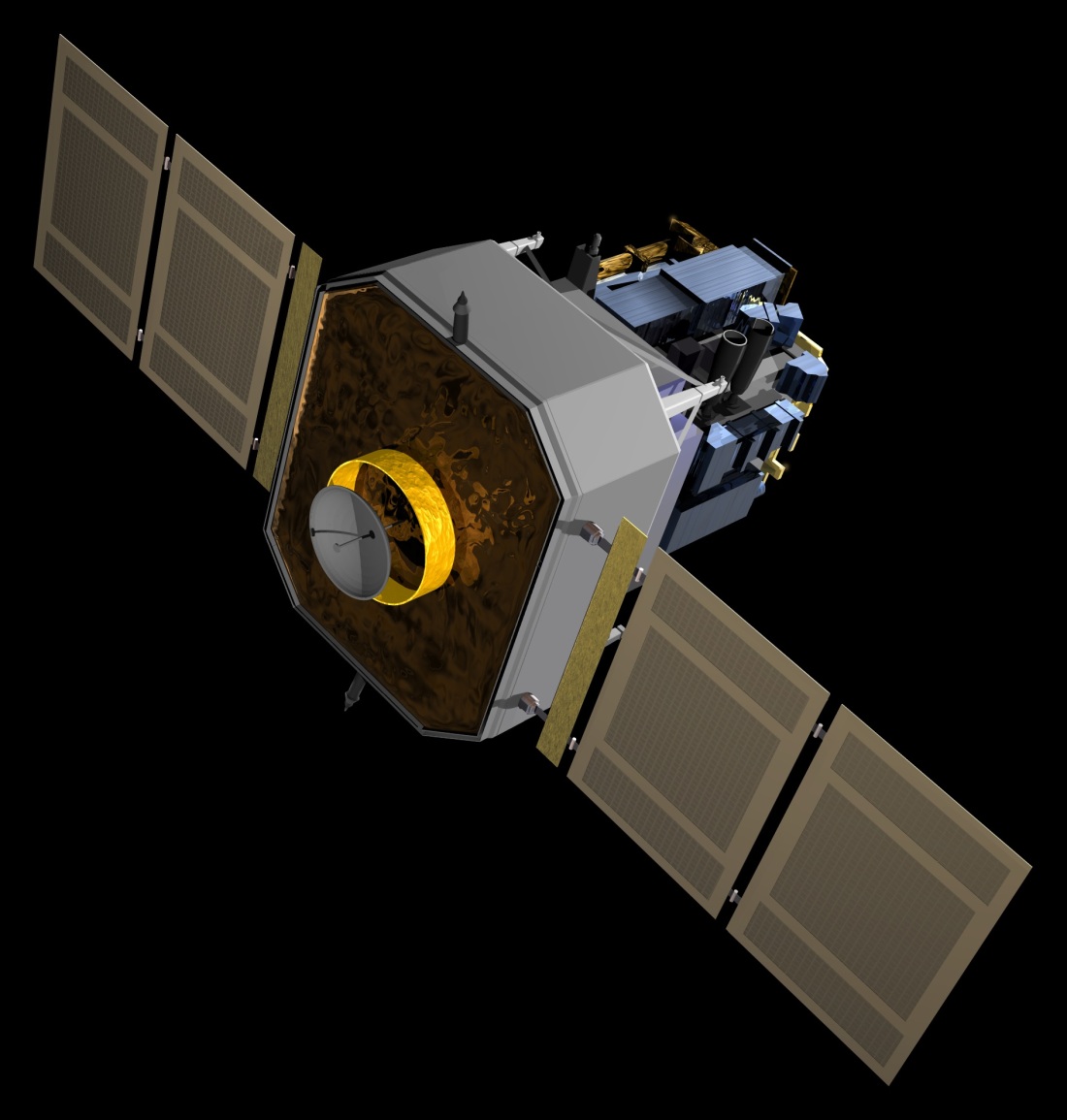 European Space Agency [Agence spatiale européenne](EU)/National Aeronautics and Space Administration(US) SOHO satellite. Launched in 1995.
European Space Agency [Agence spatiale européenne](EU)/National Aeronautics and Space Administration(US) SOHO satellite. Launched in 1995.
 National Aeronautics Space Agency(US) NASA Kepler Space Telescope (US)
National Aeronautics Space Agency(US) NASA Kepler Space Telescope (US)
CfA-led discoveries throughout this period include canonical work on Supernova 1987A, the “CfA2 Great Wall” (then the largest known coherent structure in the Universe), the best-yet evidence for supermassive black holes, and the first convincing evidence for an extrasolar planet.
The 1990s also saw the CfA unwittingly play a major role in the history of computer science and the internet: in 1990, SAO developed SAOImage, one of the world’s first X11-based applications made publicly available (its successor, DS9, remains the most widely used astronomical FITS image viewer worldwide). During this time, scientists at the CfA also began work on what would become the Astrophysics Data System (ADS), one of the world’s first online databases of research papers. By 1993, the ADS was running the first routine transatlantic queries between databases, a foundational aspect of the internet today.
The CfA Today
Research at the CfA
Charles Alcock, known for a number of major works related to massive compact halo objects, was named the third director of the CfA in 2004. Today Alcock overseas one of the largest and most productive astronomical institutes in the world, with more than 850 staff and an annual budget in excess of $100M. The Harvard Department of Astronomy, housed within the CfA, maintains a continual complement of approximately 60 Ph.D. students, more than 100 postdoctoral researchers, and roughly 25 undergraduate majors in astronomy and astrophysics from Harvard College. SAO, meanwhile, hosts a long-running and highly rated REU Summer Intern program as well as many visiting graduate students. The CfA estimates that roughly 10% of the professional astrophysics community in the United States spent at least a portion of their career or education there.
The CfA is either a lead or major partner in the operations of the Fred Lawrence Whipple Observatory, the Submillimeter Array, MMT Observatory, the South Pole Telescope, VERITAS, and a number of other smaller ground-based telescopes. The CfA’s 2019-2024 Strategic Plan includes the construction of the Giant Magellan Telescope as a driving priority for the Center.
 CFA Harvard Smithsonian Submillimeter Array on MaunaKea, Hawaii, USA, Altitude 4,205 m (13,796 ft).
CFA Harvard Smithsonian Submillimeter Array on MaunaKea, Hawaii, USA, Altitude 4,205 m (13,796 ft).
 South Pole Telescope SPTPOL. The SPT collaboration is made up of over a dozen (mostly North American) institutions, including The University of Chicago (US); The University of California Berkeley (US); Case Western Reserve University (US); Harvard/Smithsonian Astrophysical Observatory (US); The University of Colorado, Boulder; McGill(CA) University, The University of Illinois, Urbana-Champaign;The University of California, Davis; Ludwig Maximilians Universität München(DE); DOE’s Argonne National Laboratory; and The National Institute for Standards and Technology. The University of California, Davis; Ludwig Maximilians Universität München(DE); DOE’s Argonne National Laboratory; and The National Institute for Standards and Technology. It is funded by the National Science Foundation(US).
South Pole Telescope SPTPOL. The SPT collaboration is made up of over a dozen (mostly North American) institutions, including The University of Chicago (US); The University of California Berkeley (US); Case Western Reserve University (US); Harvard/Smithsonian Astrophysical Observatory (US); The University of Colorado, Boulder; McGill(CA) University, The University of Illinois, Urbana-Champaign;The University of California, Davis; Ludwig Maximilians Universität München(DE); DOE’s Argonne National Laboratory; and The National Institute for Standards and Technology. The University of California, Davis; Ludwig Maximilians Universität München(DE); DOE’s Argonne National Laboratory; and The National Institute for Standards and Technology. It is funded by the National Science Foundation(US).
Along with the Chandra X-ray Observatory, the CfA plays a central role in a number of space-based observing facilities, including the recently launched Parker Solar Probe, Kepler Space Telescope, the Solar Dynamics Observatory (SDO), and HINODE. The CfA, via the Smithsonian Astrophysical Observatory, recently played a major role in the Lynx X-ray Observatory, a NASA-Funded Large Mission Concept Study commissioned as part of the 2020 Decadal Survey on Astronomy and Astrophysics (“Astro2020”). If launched, Lynx would be the most powerful X-ray observatory constructed to date, enabling order-of-magnitude advances in capability over Chandra.
 NASA Parker Solar Probe Plus named to honor Pioneering Physicist Eugene Parker.
NASA Parker Solar Probe Plus named to honor Pioneering Physicist Eugene Parker.
 National Aeronautics and Space Administration(US)Solar Dynamics Observatory(US)
National Aeronautics and Space Administration(US)Solar Dynamics Observatory(US)
 Japan Aerospace Exploration Agency (JAXA) (国立研究開発法人宇宙航空研究開発機構] (JP)/National Aeronautics and Space Administration(US) HINODE spacecraft.
Japan Aerospace Exploration Agency (JAXA) (国立研究開発法人宇宙航空研究開発機構] (JP)/National Aeronautics and Space Administration(US) HINODE spacecraft.
SAO is one of the 13 stakeholder institutes for the Event Horizon Telescope Board, and the CfA hosts its Array Operations Center. In 2019, the project revealed the first direct image of a black hole.
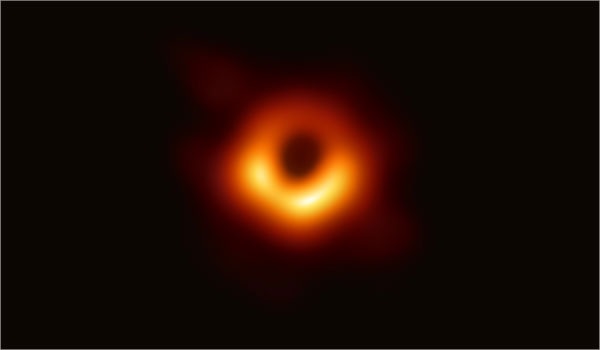 Messier 87*, The first image of the event horizon of a black hole. This is the supermassive black hole at the center of the galaxy Messier 87. Image via The Event Horizon Telescope Collaboration released on 10 April 2019 via National Science Foundation(US).
Messier 87*, The first image of the event horizon of a black hole. This is the supermassive black hole at the center of the galaxy Messier 87. Image via The Event Horizon Telescope Collaboration released on 10 April 2019 via National Science Foundation(US).
The result is widely regarded as a triumph not only of observational radio astronomy, but of its intersection with theoretical astrophysics. Union of the observational and theoretical subfields of astrophysics has been a major focus of the CfA since its founding.
In 2018, the CfA rebranded, changing its official name to the “Center for Astrophysics | Harvard & Smithsonian” in an effort to reflect its unique status as a joint collaboration between Harvard University and the Smithsonian Institution. Today, the CfA receives roughly 70% of its funding from NASA, 22% from Smithsonian federal funds, and 4% from the National Science Foundation. The remaining 4% comes from contributors including the United States Department of Energy, the Annenberg Foundation, as well as other gifts and endowments.


